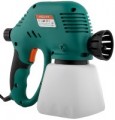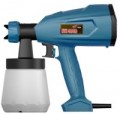Power consumption
The power consumed by the operation of an electric tool (see "Type").
Most modern spray guns, even performant ones, have a rather low power: for example, models
with more than 1 kW are extremely rare, and in most cases, power consumption does
not exceed 500 W at all. So when connecting such equipment to sockets, there are usually no problems; only single units of high performance, requiring 3.5 kW or more, have to be connected according to special rules (directly to the shield). In other cases, data on power consumption is most often not needed for normal use and may be required only for specific tasks — for example, to calculate the load on an autonomous generator.
Rated pressure
Nominal air pressure in the spray gun.
The general meaning of this parameter depends on the type of instrument (see above). So, in pneumatic models, nominal pressure data is required for connection to an external compressor. It is this pressure that this compressor must create at the inlet to the atomizer; too low values will lead to a decrease in efficiency, too high are fraught with breakdowns and even accidents with injury to others.
In turn, for electric models, the nominal pressure is the air pressure created by the unit's own compressor; the complete atomizer was originally designed for the same pressure. So in this case, this parameter is more of a reference than practically significant; it may be useful only for connecting replacement nozzles to the compressor (or vice versa, for using an existing nozzle with a third-party compressor).
As for specific pressure values, they are primarily determined by the spray system (see below). The diversity here is quite high: the most modest units give out
less than 2 bar,
2-5 bar compressors are quite popular
, 5-10 bar models are relatively rare, and some powerful performance solutions provide a pressure of
100 bar or more.
Paint consumption
Consumption of paint or other material (for example, mortar for plaster) when the spray gun is operating in normal mode.
The higher the flow rate, the more material the tool can apply per unit of time, the better it is suitable for processing large areas and for applying thick coatings. On the other hand, not all types of work require high productivity, and sometimes relatively low consumption is optimal. Detailed recommendations on this subject for different situations can be found in special sources.
Maximum viscosity
The maximum viscosity of the paint or other working material at which the spray gun is able to work normally. Specified in DIN units; a certain DIN in this case is the number of seconds it takes for a standard volume of paint (usually 100 mL) to pour out of a funnel with a strictly defined pour hole diameter (usually about 4 mm). Such a funnel (viscometer) can be supplied with the spray gun, but if necessary, it can be purchased separately.
Thus, the larger the DIN, the more viscous the composition is. And the larger the number indicated in the characteristics of the spray gun, the wider its capabilities, the thicker liquids can be poured into it without fear of clogging and breakage. At the same time, it should be taken into account that in fact it is not so often necessary to work with thick liquids — on the contrary, excessive viscosity worsens the quality of the coating, leads to streaks and increases the drying time. For example, most enamels and oil paints are used at a viscosity of about 20 DIN, latex paints up to 45 DIN, etc. General recommendations on this matter can be found in special sources, and specific ones can be found on the packaging of a particular brand of paint or other composition.
Spraying
Spray method used by the spray gun.
— Pneumatic. Pneumatic (air) spray tools work on the principle of a spray gun: paint particles are captured by the air stream flowing from the nozzle and transferred to the surface to be painted. This method is standard for pneumatic tools, but it is also common in other types (see above). The advantages of pneumatics are the excellent uniformity of application and the aesthetic appearance of the resulting coating, as well as its versatility — it can be used both for small jobs and for large surfaces, for objects of any complexity and with almost any type of paint and varnish materials. And the equipment is relatively simple and inexpensive. The main disadvantages of this method are high fogging (which requires good ventilation and protective equipment, and also increases material consumption) and the need to dilute the material to a working consistency (which, in turn, affects the consumption of solvents).
—
Airless. Airless spraying is based on forcing the paint material with a special high pressure pump; roughly speaking, the spray gun "spits out" the paint through a nozzle, spraying it into a stream of the desired shape. The key advantages of this method over the pneumatic one are, firstly, high productivity (including due to higher efficiency and lower material losses), and secondly, the absolute minimum of fogging. It is also worth noting the low consumption of solvents and a clear
...border of the edges of the treated area. At the same time, the uniformity and appearance of the coating during such work is much worse than with air spraying, the uniformity is lower, and the equipment turns out to be expensive and difficult both in itself and in maintenance. Therefore, airless spray is recommended for large areas where productivity is more important than high quality. In addition, this option is indicated for rollers (see "View"): in them the technology is somewhat different from that described, but it also does not imply a supply of compressed air.Container volume
The total volume of the paint reservoir supplied with the gun.
Large tank, on the one hand, allows you to "charge" a lot of material and work for a long time. On the other hand, it increases the size and weight of the device; and a large amount of paint will also weigh accordingly (although for models with a separate tank location - see above - this is not critical). Therefore, the thinner and more delicate the work for which the spray gun is designed, the, as a rule,
the smaller the tank volume : for example, in airbrushes (see "View") it rarely exceeds 50 ml, and in plaster models, in turn, can be measured liters. Therefore, most models have a volume of no more than a liter, namely
500 ml,
600 ml,
700 ml,
800 ml,
1000 ml.

